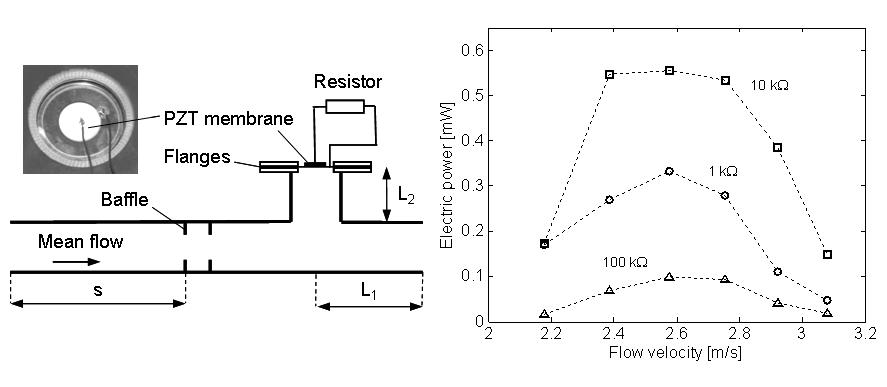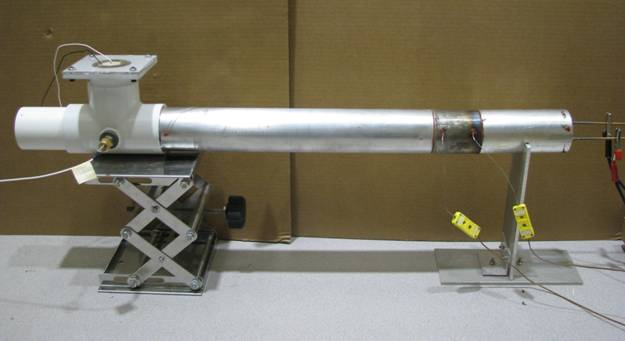
Sungmin Jung
MME School, Washington State University
Pullman, WA 99164-2920
Rafael Hernandez
MME School, Washington State University
Pullman, WA 99164-2920
Konstantin I. Matveev – matveev@wsu.edu
MME School, Washington State University
Pullman, WA 99164-2920
Popular version of paper 4aEAa
Presented Thursday morning, November 3, 2012
152nd ASA Meeting, San Diego, CA
High-amplitude tonal sound may appear inside duct systems due to excitation of acoustic resonances by unsteady heat release or vortex shedding in the presence of mean flow. Noise generation in ventilation systems and unstable combustion coupled with acoustic oscillations in rocket motors and industrial burners are examples of undesirable and often harmful phenomena. In thermoacoustic engines, acoustic waves are excited intentionally with a purpose of converting waste heat or solar radiation into useful forms of energy. The power of excited tonal sound in these systems can be harvested by electroacoustic transducers and applied for powering sensors and other small-scale devices, thus eliminating a need for battery replacement.
To demonstrate harnessing energy of vortex-driven sound, we constructed a simple system consisting of several pipe sections, a pair of baffles, and a piezoelement (Fig. 1). Mean flow was provided by a blower. The airflow around baffles is unstable. Vortices detach from the upstream baffle and impinge on the downstream baffle. At proper correlation between baffle spacings and mean flow velocities, a part of the flow energy is fed into acoustic modes of the pipe. The baffle positions favorable for a particular mode excitation usually correspond to the velocity anti-nodes in this mode. The acoustic energy harvester employed in this study was a brass disk with a PZT layer.
We carried out tests at several mean flow rates. Sound pressure levels measured inside the tube reached 135 dB in some conditions. The harvested electrical power in a range of flow rates corresponding to a single loud tone with frequency around 450 Hz is shown in Fig. 1. Among three passive electrical loads used with the piezoelement, a 10-kΩ resistance resulted in the largest harvested power for all studied flow rates, although the highest voltages were usually produced at the highest resistance. The maximum power of about 0.55 mW was harnessed at the mean airflow velocity of about 2.6 m/s.

Figure 1. Left: setup for harvesting energy of vortex-driven sound; right: generated electric power.
Thermoacoustic engines are novel systems for transforming heat into electricity. This is done by first exciting a tone inside the engine resonator, and then converting sound power into electrical power. Typical engines consist of pipe sections with a porous material inset across which a temperature difference is maintained. Acoustic modes become unstable in the presence of sufficiently large temperature gradients. An example of one of our tabletop engines is shown in Fig. 2. Under temperature differences of about 300 K across a 5-cm-long square-pore ceramic matrix, a tonal sound was excited. The electric power harnessed by a piezoelement in this setup reached 0.45 mW on a 15-kOhm electrical resistance.

Figure 2. Standing-wave thermoacoustic engine with a piezoelement.
The power levels recorded in this study are already sufficient for some low-power sensors.
No optimization of the system geometry or circuitry of the piezoelement has been performed yet. After bringing the resonance frequency of the disc with piezoelectric layer down to the excited sound frequency and implementing other improvements, the system power output can be substantially increased. It can be expected that piezoelements will become a viable source of alternative energy for powering sensors or other small devices using acoustically unstable resonators with mean flow or heat addition.
http://www.mme.wsu.edu/~matveev/
This material is based upon work supported by the National Science Foundation under Grant No. 0853171.